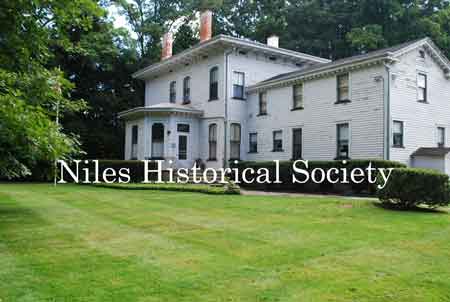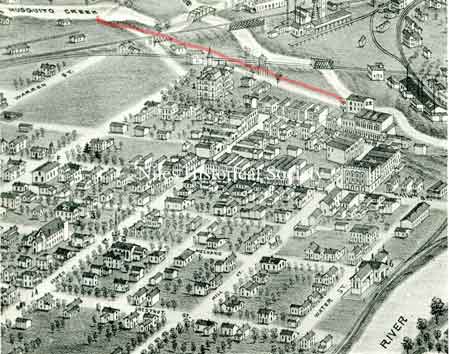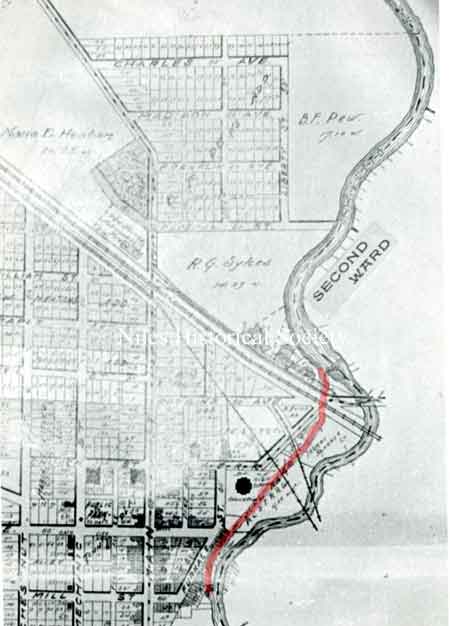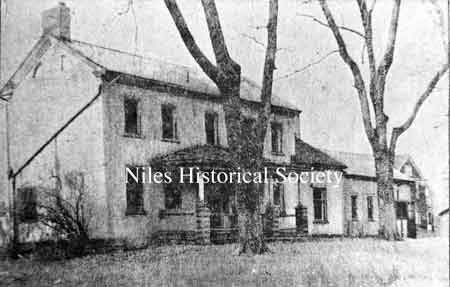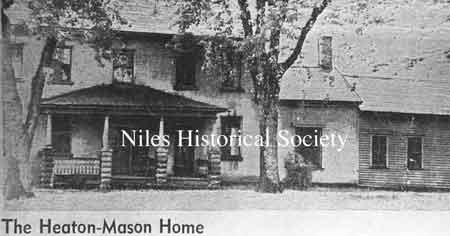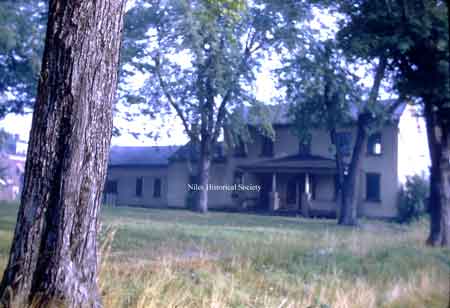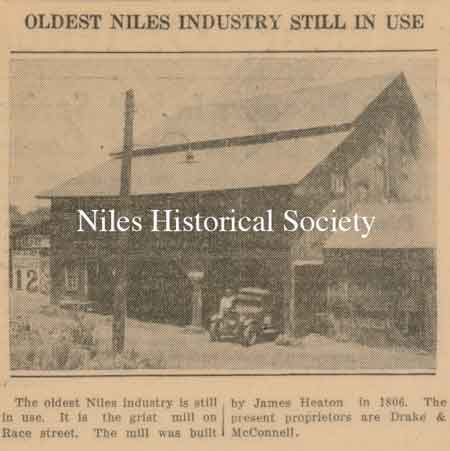
Grist Mill as it appeared in 1934.
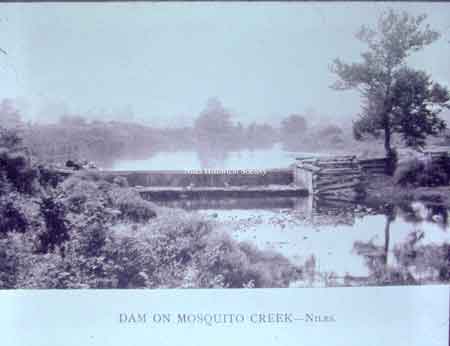
Early image of the Mosquito Creek
dam. SO1.399
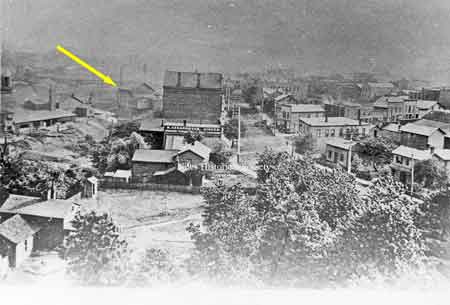
View from Central School looking south
in downtown Niles. It looked like this about 1900 when you glanced
south down Furnace Street (now State Street) The tall building beyond
Abramson Stoves and the hardware store is the Mango Block, and the
grist mill(yellow arrow)built originally by
Heaton. Smoke from the mills and frame buildings were the familiar
sights of the day.
PO1.883
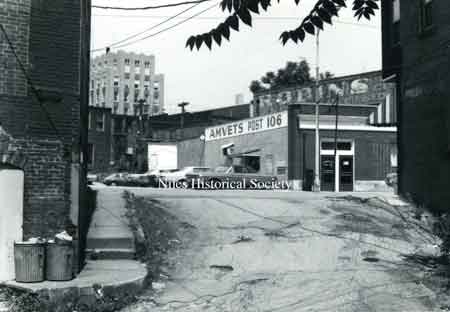
Entrance to Race Alley from East
State Street.
PO1.196 |
The
History of James Heaton's Grist Mill.
Niles' First Industry
This article appeared in the Niles Daily Times Bicentennial
Edition issued in 1934
The two brothers, Daniel and
James Heaton constructed, on Yellow Creek in Poland, Ohio,
the first blast furnace in the Mahoning Valley and probably the
first blast furnace west of the Alleghenies, thus becoming the founders
of the industry that eventually made the region one of the leading
industrial areas in the United States.
In about 1806, James Heaton selected
as his permanent settlement the vicinity near the junction of Mosquito
Creek and the Mahoning River. He purchased the land along the
creek for at least a mile and a half north of the river. He built
his home, a saw mill and a grist mill. This was the first industry
in what is now called Niles.
The first project by James Heaton
was the construction, about 1806 or 1807, of a sawmill and gristmill,
an enterprise certain to be useful and necessary in a growing pioneer
community. This was the first industry in what is now Niles. The
sawmill was abandoned in the course of time, but the old gristmill,
rebuilt to some extent in 1839, and bearing the deep scars of a
century on its sturdy timbers, is still in use, the present proprietors
being Drake and McConnell. Built of oak planks
two feet wide and two and one-half inches thick, and axe-hewn beams
and pillars more than one foot square, the parts fitted and held
together with wooden nails, the old gristmill still stand as a century-old
monument to the hard labor and capable workmanship of the pioneer
builder. The saw mill was abandoned, but
the old grist mill, with its sturdy timbers was still in use in
1934 by Drake and McConnell.
During the more than a century of
its existence the gristmill has naturally passed through the hands
of a number of proprietors. One of them, Dr. A.G. Miner,
in 1888 installed steam power for use in times of low water. The
present owners took charge in 1908. Since about 1929 the mill machinery
has been silent, and the mill is now used as a warehouse for the
distribution of flour and other products milled elsewhere.
To power the mill, James Heaton utilized
the only available source, water. At the site of the present dam
on the Mosquito Creek, he constructed a dam and south of that the
gate and entrance to a mill race, leading to a huge wooden water
wheel at the mill, a third of a mile distant. After the introduction
of the electric power in 1915, the need for the mill race passed
and finally the old land mark disappeared when the park commission
in 1927 filled in the abandoned bed as a part of the Central Park
improvement program.
The Grist Mill building stood for
sometime as a warehouse for the distribution of flour and other
products milled elsewhere. In 1940 the Niles Daily Times reported
the story of the blaze that destroyed the city's oldest landmark,
the Grist Mill built in 1806-1807 by James Heaton on what later
became known as Race Alley, a narrow path from the dam to the grist
mill.
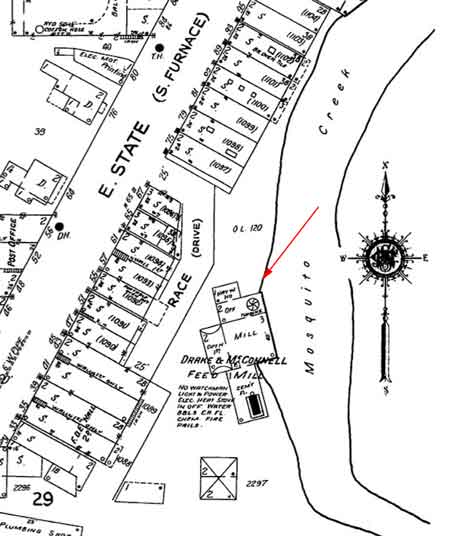 1924
street map showing the location of the Drake-McConnell Feed Mill. 1924
street map showing the location of the Drake-McConnell Feed Mill.
It was situated along the Mosquito
Creek and accessed from East State Street, formerly South Furnace
Street, by Race Drive.
The mill raceway which powered the
water wheel of the grist mill has been covered up and buildings
are now located over that area.
|
| 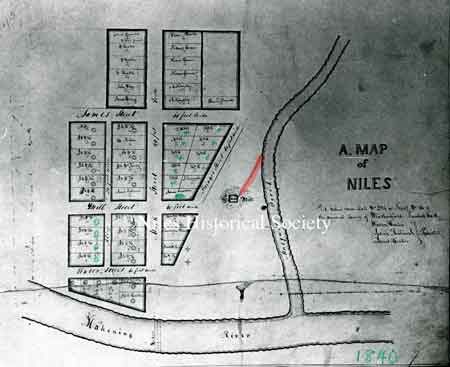
PO1.665
1840 Map of Niles. |
1840
Map of Niles.
Of the 54 lots platted in 1834, they
were listed as follows:
23 lots, James & Warren Heaton
12 lots - Heaton & Robbins
Lot 18 - M. Rider
Lot 20 - William McKinley Sr.
Lot 22 - Jacob Robinson
Lot 29 - Ambrose Mason |
Lot
31 - James Heaton
Lot 37 - J. Frederick
Lot 42 - David Bowell
Lots 43 & 44 - A. Kingsley
Lots 45,46 & 47 - Thomas Evans
Lot 49- school grounds
Lots 48,50,51 & 52- Warren
Heaton
Lot 53 - John Dray
Lot 54 - James Dempsey
|
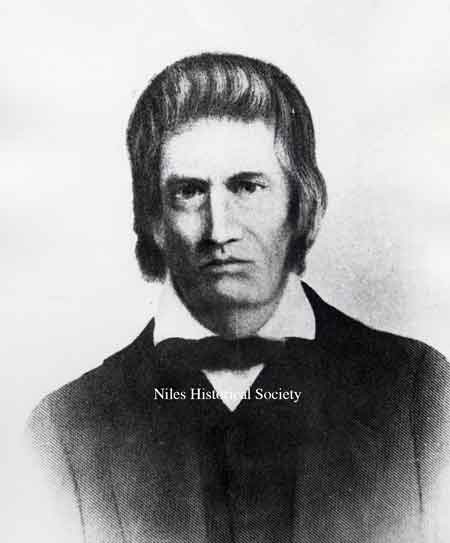
Drawing of James Heaton, founder of Niles.
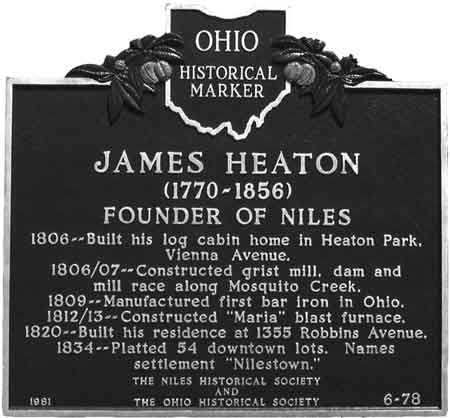
|
After building his grist mill, James Heaton constructed
in 1809 a blooming forge here, which manufactured the first bar
iron in Ohio. The pig iron for this product, Heaton had obtained
from the Yellow Creek furnace in Poland, Ohio; but when war was
declared in 1812 the furnace men enlisted or were drafted and the
furnace closed. James Heaton immediately made plans to supply his
own pig iron requirements and in so doing developed an industry
that for many years was to attract settlers to the new community
in Weathersfield Township.
The Heaton forge is believed to have stood on the
bank of the Mosquito Creek near the Baltimore and Ohio railroad
bridge across the creek. In 1812 James Heaton borrowed $1,448 from
his brother, John, and in 1813 completed the construction of a charcoal
blast furnace capable of producing the pig iron need for the manufacture
of bar iron and other products at the Heaton forge. He named his
blast furnace “Maria Furnace” in honor of his daughter,
Maria , believed to be the first white child born in Niles.
By 1834 the settlement had
reached the proper proportions of a village so James Heaton planned
the streets, marked off the lot division and named the village.
Until 1834 the settlement was appropriately called “Heaton’s
Furnace”, but James Heaton gave it a new name “Nilestown”
in honor of Hezekiah Niles , editor of the Niles Register,
a Baltimore paper, who’s whig principals Heaton greatly admired.
Nilestown remained the name until 1843 when the Post Office Department
for convenience shortened it to “Niles” and that is
how Niles got its name.
Ohio Historical marker listing James
Heaton's accomplishments located on South Main Street across from
The McKinley Museum and Research Center. |
